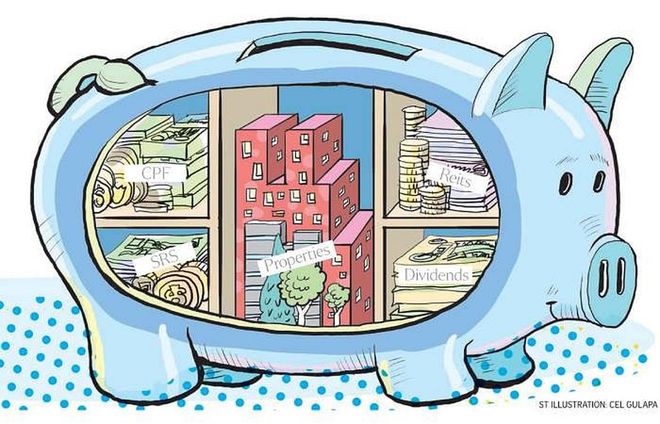How To Invest For Extra Income
Property rental, dividend stocks, Reits and bonds are some avenues you can consider


Photo: Getty
Investment
Investing for income involves putting together a strategy to generate a steady cash payout from a portfolio of assets - essentially a process where you save money to make money while you sleep.
Many people think this strategy is only for older folk who are nearing retirement or already retired. But having a steady stream of passive income can be empowering and some younger people use it as a gauge to see whether they are on track to achieving financial freedom.
You technically do not need a full-time job if your average monthly passive income covers your monthly expenses.
Financial blogger Kyith Ng, who owns the popular Investment Moats blog, says there are two parts to investing for income: "If you need an income, you have to start from how much you need in the first place. When you have figured out whether you need $36,000, $48,000 or even $100,000 a year, then you need to look at how much investible assets you have. With these two, you can go ahead and think about generating that income."
As a rule of thumb, annual expenses divided by investible assets should be around 3 per cent to 4 per cent for the savings to last 30 to 40 years.
For example, if you want $36,000 a year, then you will need around $1 million in investible assets to generate that income.
To AIA financial services director Jamson Chia, investing for income is like growing a garden. "It requires time, patience and loads of attention. The hardest part of this journey is to take the first step, and decide how you want your investment portfolio to look like," he says.
WHAT TYPES OF INVESTMENT CAN INVESTORS CONSIDER?
Mr Chia suggests the portfolio could be made up of five key areas of investments: the Central Provident Fund (CPF), the Supplementary Retirement Scheme (SRS), properties, real estate investment trusts (Reits) and dividend stocks, as well as annuities.
"They could help you grow your income, achieve financial security and peace of mind in a sustainable way for the long term. They are like the seeds you can choose to grow your garden," he adds.
Ms Adelina Koh, a financial consultant from a local financial advisory firm, notes that many types of investment exist to give income.
"Singaporeans are very in love with property investment but rental yield seems rather low now," she warns.
"Some may look to property investments overseas but one will need to consider the withholding and capital gains tax as well as geographical and currency risks."
Other more liquid investments available are company stocks, unit trusts that aim to pay out dividends (typically bond or equity based), Reits, bonds that pay out coupons and alternative investments like private equity and private businesses, she adds.
Mr Adam Wong, editor of The Fifth Person, an investment website that focuses on Asian and United States equity research, advocates looking at stocks that pay a steady dividend.
"Investors probably want to pick a larger, more stable company that has a consistent track record of dividends," he says.
"DBS is a good example of a blue-chip stock that pays a steady dividend. It pays about $1.20 in dividends (based on the 2018 payout), and the yield can be quite decent based on when you pick up the stock." (DBS shares closed at $25.31 on Friday, which gives a dividend yield of 4.74 per cent).
Mr Wong thinks Reits are also a great option for dividends since they distribute at least 90 per cent of their income to unit-holders.
"Similar to stocks, you want to choose a Reit that generates strong rental income and has a track record of paying a steady or rising dividend.
"However, Reits have run up in price over the past year, so their yields may not be so attractive right now. So investors may want to wait for a better time to re-consider them."
Related article: 5 Basic Steps To Retirement Planning For Young Couples
WHAT ARE THE STEPS THEY CAN TAKE TO START?
Mr Wong notes that before anyone starts investing, the first step is to be able to save money.
"There's no point reading all the books, poring over charts, or learning about key financial ratios when you don't even have the money to invest in the first place," he says.
"But once you have saved up an investible pool of funds, it's important to know what to do with it and how to safely invest your money for the long term.
"As bad as not saving is, saving and then losing all your hard-earned savings - this is going to make you feel a lot worse!"
Mr Wong stresses the importance of learning how to do research and analysis on great dividend companies, read financial statements, calculate a stock's intrinsic value and manage your risk.

ST ILLUSTRATION: CEL GULAPA
Investments ST
Mr Ng, of Investment Moats, recommends that investors use a diversified and low-cost exchange-traded fund (ETF) portfolio comprising equities and bonds to generate income.
"The equities portion of the portfolio will give the greatest probability of earning a higher (than) expected return. For the portfolio to last 30 to 40 years, you will need this. The bonds part will provide the stability," he says.
One way to get a regular income from this portfolio is to sell the units on a monthly basis using the draw-down concept, he notes.
And if the portfolio gives a dividend cash flow of, say, 1.6 per cent, you can sell the other 2.4 per cent of the portfolio to get your total income, he adds.
"This is a low-effort method for people who don't know anything and don't want to be involved in any tactical allocation to shift their money here and there frequently. It allows you to live your life."
Otherwise, investors could choose a more "gung ho" method of dividend investing to generate an income, which Mr Ng describes as being similar to a job.
"It requires competency and investors need to spend enough time to get confident in managing their own portfolio. If you have spent your whole life holding cash, it's very challenging to switch out from that to put $1 million into 10 to 20 stocks," he notes.
Based on his own experience of building and growing his dividend portfolio, Mr Ng thinks an average investor may need at least five to seven years of conscientious effort to get good at operating such a portfolio.
"Even then, maybe only about 50 per cent of the people who try, succeed," he says.
Related article: 54 Ways To Save And Get Savvy With Your Money
WHAT SHOULD INVESTORS LOOK OUT FOR?
Ms Koh points out that past dividend or coupon records matter for people looking for income.
"For example, I put some retiree clients in an Asian income fund for dividend income. The past dividend history will show how the dividends increase and decrease against a market cycle of boom and recession," she says.
And investors should also consider the reliability of the underlying assets.
"Quite a lot of people were caught by surprise by the Hyflux crisis. So even when you are invested, you need to constantly read the annual reports or fact sheets of the investment and keep abreast of the trends that may boost or threaten its viability," she adds.
Continuing on his gardening analogy, AIA's Mr Chia also notes the need for investors to remove the weeds from the garden.
"Along the way, due to climate change and preference change, certain crops may no longer be a good fit in your garden.
"Weeds may also grow that take away nutrients and water from the plants," he says.
"This is the time when you really need to remove these impediments, and focus on growing the investments that would bring sustainable investment returns for the long term."
Mr Wong observes that some income investors tend to ignore the overall aspects of a company's fundamentals and focus primarily on the amount of dividends they can receive.
"While dividend is obviously important to an income investor, it is also important to consider the overall health of the company.
"A company with deteriorating fundamentals - such as falling revenue, profits, cash flow, weakening economic moat - cannot sustain or grow its dividend in the long term," he says.
Related article: 20 Ways To Stretch Your Dollar Right Now
HOW TO MAKE $1,500 A MONTH THROUGH INVESTING?
Ms Koh notes that while many like to invest in property for income, interest-rate fluctuations and government policies have made it more difficult to achieve a sustainable stream of payouts in recent times.
"To earn $1,500 a month, given 4 per cent returns a year, you only need about $450,000 set aside," says Ms Koh.
"You can consider a balanced fund like Asian bonds with Asian equity that aims to give income as the fluctuations are lower than one single Asian company stock."
She notes that some single-premium endowment products that provide lifetime coupons of around 3 per cent to 4 per cent are also getting popular.
"This is suitable for lazy investors as they need not monitor the investing, which is taken care of by the insurer," she notes.
Mr Wong thinks the most sustainable way to make $1,500 a month is to invest in a basket of blue-chip stocks and Reits that pay a steady dividend.
"Assuming a 5 per cent average yield, you'd need $360,000 to generate $18,000 in dividends annually.
"The bad news is not many people have $360,000 sitting around. The good news is you can start small and build your way up," he says.
Mr Wong emphasises that time is the friend of the long-term investor. "If you are patient and disciplined, and invest $500 every month at 5 per cent per year, it will grow to $360,000 in less than 30 years. And if you are able to save more, you will reach your target faster. Remember, the first step to investing is to save money."
This article originally appeared on The Straits Times.